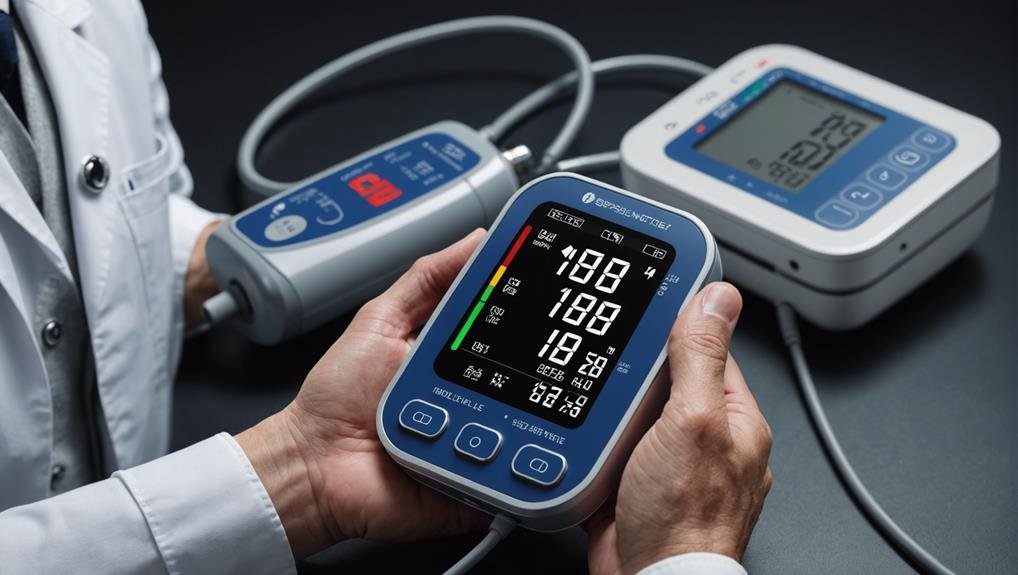Blood Pressure: Focus on Systolic Reading
Understanding the systolic blood pressure reading is essential in managing your cardiovascular health. This measurement reflects the force your heart exerts when pumping blood. Elevated systolic pressure can increase the risk of stroke, heart disease, and damage to your arteries. Lifestyle changes like regular exercise, maintaining a healthy weight, and reducing sodium intake can help lower high systolic readings. Additionally, a heart-healthy diet and stress-reducing techniques play important roles. Medication may be necessary in some cases. By prioritizing your systolic blood pressure, you are taking proactive steps towards a healthier you.
Key Takeaways
- Lifestyle modifications crucial for managing high systolic pressure
- Encouraging physical activity aids in lowering systolic blood pressure
- Maintaining healthy weight is beneficial for managing systolic pressure
- Reducing sodium intake can help lower systolic blood pressure
- Keeping systolic blood pressure within healthy range reduces risks of stroke and heart disease
Importance of Systolic Blood Pressure
When evaluating blood pressure, healthcare providers prioritize the systolic reading as it directly reflects the heart's pumping force. Lifestyle modifications and dietary changes play a vital role in managing high systolic pressure.
Encouraging physical activity, maintaining a healthy weight, and reducing sodium intake are key lifestyle changes that can help lower systolic blood pressure. Additionally, incorporating a diet rich in fruits, vegetables, and whole grains while limiting saturated fats and cholesterol can positively impact systolic readings.
These adjustments aim to reduce the workload on the heart and improve overall cardiovascular health. By implementing these lifestyle modifications and dietary changes, individuals can effectively lower their systolic blood pressure and decrease the risk of associated cardiovascular complications.
Risks Associated With High Systolic Pressure
High systolic pressure greatly enhances the likelihood of stroke and heart disease, posing a substantial risk to cardiovascular health.
When your systolic blood pressure is consistently high, it strains the arteries, leading to potential damage over time. This heightened pressure increases the risk of atherosclerosis, where fatty deposits build up in the arteries, potentially causing blockages that can lead to heart attacks or strokes.
The force exerted by the elevated systolic pressure can weaken the walls of blood vessels, making them prone to aneurysms, which are dangerous bulges that can rupture.
Keeping your systolic blood pressure within a healthy range is essential in reducing the risks associated with stroke and heart disease.
Managing Elevated Systolic Readings
Elevated systolic readings necessitate careful management to mitigate the heightened risks associated with stroke and heart disease. Lifestyle changes play a vital role in managing high systolic blood pressure. Implementing a heart-healthy diet rich in fruits, vegetables, and whole grains while limiting salt intake can help lower elevated readings.
Regular physical activity, such as aerobic exercises, contributes to improving overall cardiovascular health. Additionally, reducing stress through relaxation techniques like meditation or yoga may aid in controlling blood pressure.
In cases where lifestyle modifications are insufficient, medication options like ACE inhibitors, diuretics, beta-blockers, or calcium channel blockers may be prescribed by healthcare providers to effectively manage elevated systolic readings. Regular monitoring and adherence to treatment plans are essential in achieving the best blood pressure control.
Conclusion
Now that you understand the importance of focusing on your systolic blood pressure reading, take action to manage and control it effectively.
High systolic pressure increases your risk of stroke and heart disease, so monitoring and maintaining a healthy level is vital for your cardiovascular well-being.
By taking steps to lower your systolic pressure through lifestyle changes and medication if necessary, you can reduce your risk and guarantee a healthier heart for the future.







